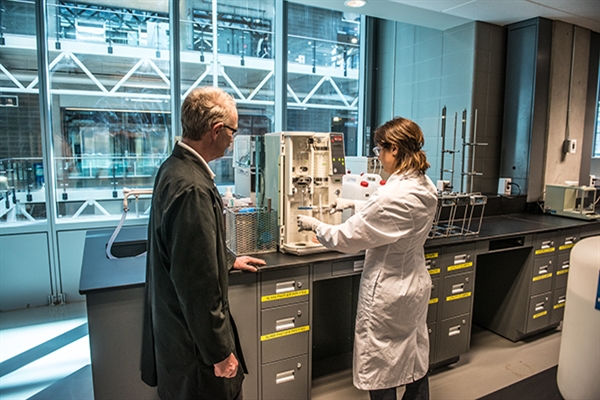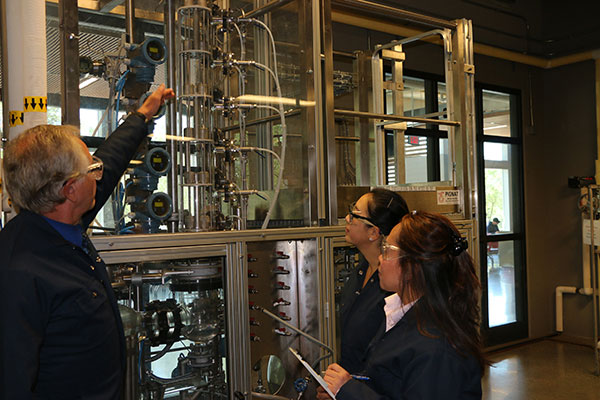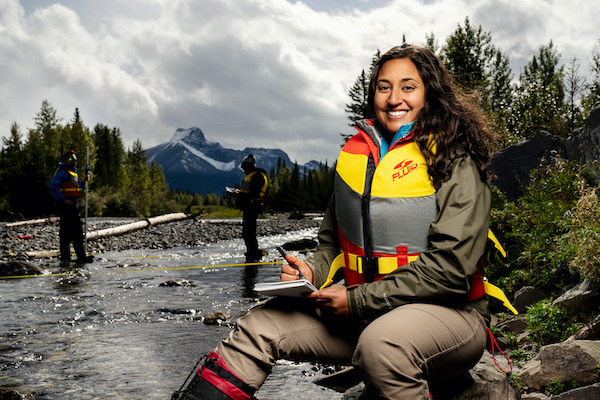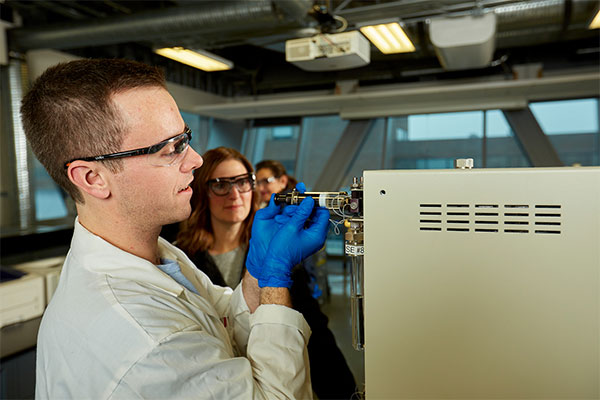How coffee grounds took this SAIT student from barista to lab technologist

Back when he worked in a coffee shop, serving lattes and cappuccinos to throngs of thirsty customers, King Veloso could never have guessed how far the coffee bean would take his education — or his career.
For his final project for the Chemical Laboratory Technology program at SAIT, Veloso used his stint as a barista for inspiration in the lab, researching more sustainable uses for coffee grounds.
“The standard filter of choice is activated carbon,” says Veloso (CLT ’22). “Using coffee grounds not only reduces waste in the landfills, it offers a more environmentally friendly solution to treating industrial wastewater.”
The capstone project, completed by Veloso and research partner John Ric Villalba (CLT ’22), was one of eight finalists recognized by the Association of Science and Engineering Technology Professionals of Alberta in the 2022 ASET Capstone Project of the Year Award.
The capstone: A career sneak-peek
The opportunity to address a real-world problem is a key element of any capstone project at SAIT, giving students a taste of life on the other side of graduation.
“Capstone projects incorporate prior learning into a final assignment with true parameters. Their research design incorporates the four-month timeline, the lab equipment needed and a defined budget,” says Daniela Lucciola, SAIT instructor. “These parameters allow students to be curious and innovative with solutions that benefit others and potentially advance the field, while applying the skills industry need in the lab.”
Veloso’s hard work and hands-on learning at SAIT percolated into his career as a lab technologist. Now he’s spilling the tea (er, coffee?) on what completing a capstone is really like.
What inspired you to take coffee grounds out of the pot and use them for filtering wastewater? ☕
My first job in Canada was working in a coffee shop where I observed that coffee grounds were thrown away with other garbage. It seemed wasteful and potentially threatening to the environment. It made sense to find an environmentally-friendly use for them.
A few years back, I studied Medical Laboratory at a prestigious university in the Philippines. The program included research opportunities, which gave me experience in handling research-based projects and helped me to understand its importance. One of the things I like to do in my free time is to read about scientific innovations and their theory, because I firmly believe we should never stop learning.
As you researched, what are some skills you learned beyond the lab? 💭
I learned perseverance, perfectionism, curiosity and openness to new experiences, along with the importance of analyzing details thoroughly. Research is very important to industry as it spurs new innovations, inventions and progress, and I think we should be investing more in research.
Were there any surprises? 😲
Yes, when we found out we had been named a finalist for the 2022 ASET Capstone Project of the Year Award. We were so excited to be nominated! It was an opportunity to raise awareness about how coffee grounds waste can be reduced, reused and recycled. This contributes to sustainability and a greener future.
What made you choose SAIT and Chemical Laboratory Technology? 🌎
I chose SAIT because it focuses on hands-on learning, especially in the laboratories and classrooms, ensuring their students have developed quality skills. By experience, I learn things quickly through hands-on, and when I saw SAIT offers practical experience and theoretical knowledge in a real-world context, I knew right away that I belong at SAIT.
I’m fond of chemistry, even back in the Philippines, I would always get above average marks in my chemistry classes. As time goes on, I did not think a chemistry-based degree would grow on me, but I’ve grown to like, if not love, Chemical Laboratory Technology. I can only commend SAIT for designing the program to be equally extensive in both hands-on and theory.
Energy and Environment programs
From working in the lab to getting out into nature, find out which program is right for you.

Chemical Laboratory Technology
-
Diploma
- Program Length: 2 years
- Campus: In person (Main Campus)
- Faculty: MacPhail School of Energy

Chemical Engineering Technology
-
Diploma
- Program Length: 2 years
- Campus: In person (Main Campus)
- Faculty: MacPhail School of Energy

Environmental Technology
-
Diploma
- Program Length: 2 years
- Campus: In person (Main Campus)
- Faculty: MacPhail School of Energy

Water and Wastewater Treatment Operations
-
Certificate
- Program Length: 1 year
- Campus: In person (Main Campus)
- Faculty: MacPhail School of Energy
Skills for the Future
We prepare students for successful careers and lives.
SAIT'S
2020-2025
Strategic plan

Oki, Âba wathtech, Danit'ada, Tawnshi, Hello.
SAIT is located on the traditional territories of the Niitsitapi (Blackfoot) and the people of Treaty 7 which includes the Siksika, the Piikani, the Kainai, the Tsuut’ina and the Îyârhe Nakoda of Bearspaw, Chiniki and Goodstoney.
We are situated in an area the Blackfoot tribes traditionally called Moh’kinsstis, where the Bow River meets the Elbow River. We now call it the city of Calgary, which is also home to the Métis Nation of Alberta.



